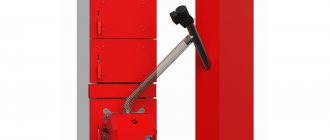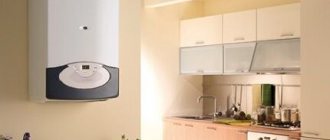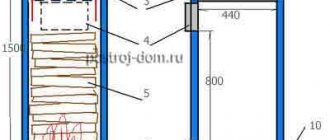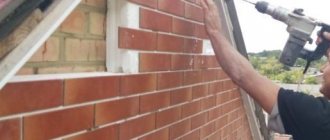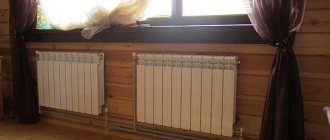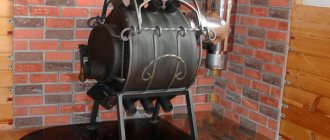Home / Solid fuel boilers
Back
Published: June 26, 2019
Reading time: 5 min
0
2310
Pellet boiler (PC) is a heat generator that is used to generate hot water for heating and hot water needs and uses solid fuel - pellets in granules.
They are made by pressing wood waste: shavings, sawdust, straw, sunflower and buckwheat husks with dimensions of 5-10 mm in diameter and up to 7 cm in length . The calorific value of pellets is 4500 Kcal/kg , which is almost equal to that of low-calorie coal and some wood output.
Modern PCs differ from conventional coal or gas boilers and consist of four main components: a boiler with a pellet burner for combustion, a pellet storage hopper, a fuel supply mechanism to the furnace and an accumulator tank.
The installation of a pellet boiler is carried out by a specialized installation organization. It is equipped with an automatic fuel loading system, which allows it to operate autonomously for several weeks.
- 1 Technical conditions for installing a pellet boiler
- 2 Requirements for the premises under the boiler
- 3 Installation location
- 4 Necessary tools and materials
- 5 Installation of a pellet boiler
- 6 First start of the boiler
Why is proper strapping so important?
Piping refers to pipes and mechanisms designed to supply coolant from the boiler to the radiators.
This is almost the entire heating system, with the exception of the batteries. The system consists of many components, but even a non-professional can install the simplest boiler piping. But if you need a complex circuit, it is better to contact an experienced craftsman.
It is better to install the boiler in a separate room, for example, in an outbuilding, boiler room or basement, because piping involves additional pipes and mechanisms, which is not always convenient. However, if there is not enough space, heating equipment is installed in the house
The choice of piping scheme for each specific house depends on the type of boiler, construction features, and type of heating system.
Any gas equipment is dangerous. Incorrect connection is fraught not only with heating problems, but also with explosions and destruction, so it is necessary to strictly follow the rules and regulations and comply with safety requirements. The main documentation that is relied upon when installing a gas heating system is SNiP.
The main unit of the system is the boiler. The piping scheme is chosen based on its type, location (wall-mounted or floor-mounted model), design features
It is necessary to carefully plan the heating scheme, the location of equipment, and the features of laying pipelines.
The boiler piping performs several significant functions at once:
- Pressure control. If the piping is installed correctly, thermal expansion is compensated, which means that the pressure in the system will not increase to critical levels.
- Removing air. Air bubbles form plugs, which reduces the efficiency of water heating: radiators do not warm up completely, but resource consumption remains the same. High-quality boiler piping is necessary to prevent this problem.
- Prevention of blockages in the system. If the boiler is not properly sealed, the risk of scale formation in radiators and pipes increases. Small debris in the coolant pollutes the system, which leads to excessive fuel consumption and increased heating costs while simultaneously reducing its quality.
- Possibility of connecting other circuits. You can install an underfloor heating system and a storage boiler.
In many ways, heat supply depends on the correct connection of the boiler to pipelines and other important components, so the gas boiler piping scheme must be carefully thought out and installed as efficiently as possible.
When installing a radial system, collector cabinets are installed where most of the boiler piping mechanisms can be mounted. It's convenient and practical
A correctly selected and installed boiler piping will last for many years without accidents or repairs, and its cost will be optimal.
The main types of homemade boilers
If you are going to make a long-burning boiler with your own hands, then you will definitely need the information from our review. In the following sections we will tell you how to make a heating unit of one design or another yourself, give several of the easiest schemes, and publish information about the most common long-burning boilers
Let's focus on the last question for now.
The time has come to consider the most current options for long-burning boilers, which we can assemble with our own hands at home. They will all eat wood. As for coal, it is more difficult to obtain, and it also leads to high temperature loads on heating units. In the following sections we will provide drawings of long-burning solid fuel boilers and provide explanatory information.
Long burning mine boiler
We can make the simplest mine boiler with our own hands. It is implemented according to a bottom combustion scheme. The basis of the unit is a capacious loading chamber, which is often called a shaft. Having a vertical design, it allows you to accommodate a large amount of firewood. As they burn, they fall down, and the combustion products are sent through the grate into the ash pan.
If we look at the diagram of a shaft furnace (boiler), we will find that the flame is raging not in the shaft at all, but in the adjacent chamber, from where the resulting heat enters the fire-tube heat exchanger. And the remaining thermal energy is sent to the chimney. The combustion here is long and is determined by the volume of the shaft - after loading a large amount of firewood here, you can safely go to bed.
Pyrolysis boiler
Let's see how a pyrolysis boiler works and how to make this unit with your own hands. The easiest way to explain the operating principle of this unit is to use the example of a potbelly stove. Here we see a volumetric combustion chamber that realizes long-lasting combustion. The resulting combustion products are sent to the afterburner chamber, into which secondary air is supplied. As a result, a large amount of heat is generated. All we have to do is retrofit the potbelly stove with a fire-tube heat exchanger.
There are dozens of drawings of long-burning wood-burning boilers built on the pyrolysis principle of operation. They differ in the location of combustion and afterburning chambers, the presence and absence of blower fans and automation, as well as methods for adjusting the intensity of the wood fuel combustion process. But in general, their operating principle is the same.
Boiler-furnaces Bubafonya
Bubafonya is a stove, and its modification is a water-heating wood-burning boiler with air supply from above, through a pressure piston. We have already written about such stoves more than once in our reviews, now it’s time to talk about units with a heating circuit. To implement the circuit, we can use three schemes:
- Installing a heat exchanger on a chimney is the easiest option;
- Build a continuous water jacket around the boiler body;
- Scald the body of the unit with the pipes through which the coolant will circulate.
Which scheme to choose is up to you. By the way, Bubafonya boilers, due to their spacious chambers, will help to realize long-term combustion lasting up to 24 hours or even more.
Long-burning boilers Bubafonya operate on wood and have an upper combustion scheme.
Boiler-furnaces Buleryan
Initially, Buleryans were (and are) convection-type ovens. They are equipped with powerful convectors, which allow you to warm up a large room in literally 20-25 minutes. Having originally appeared in Canada, these stoves reached Russia, which also boasts a harsh climate (true for some regions). Craftsmen turned stoves into boilers, having worked a little on the design of convectors - now not air, but coolant circulates through them. True, Buleryan boilers cannot boast of long-lasting combustion, since they do not have the largest combustion chambers. Some of them have the property of burning for up to 10-12 hours, some – a little longer. But you still can’t count on 24 hours. But they are characterized by high efficiency and the ability to quickly transfer heat to heating systems.
Correct boiler settings
When buying a pellet boiler, first of all you need to pay attention to the availability of service centers and official representative offices in the region where the boiler is installed. The pellet boiler is fully automated and requires proper configuration and maintenance. Correctly setting up the boiler will increase its service life, reduce fuel consumption and simplify cleaning the boiler. Start-up and commissioning of this kind of automated equipment must be carried out by a specialist authorized by the manufacturer. In fact, there are no restrictions on starting the boiler and putting it into operation; this procedure can be performed by the installer who installed the heating system, and of course by the user himself. But in this case, all responsibility and further maintenance falls on the person who carried out the launch.
What is important to know to set up a pellet boiler yourself? First of all, you need to understand that an automatic pellet boiler has several operating modes. The most basic and those that require more attention are three: Ignition, Work, Pause. Boiler manufacturers use different types of automation in which all kinds of additional modes can be used, such as: Combustion Stabilization Mode, Modulation Mode, Supervision Mode, etc. When we already have an idea of the modes, it is important to understand how the boiler should behave in each mode.
Ignition mode - when a certain portion of pellets is supplied to the burner using an igniter, or in manual mode it is ignited and complete combustion is stabilized. The boiler usually spends about fifteen minutes in this mode, during which time it also supplies pellets in certain portions, while the boiler automation monitors the temperature of the flue gases. In this mode, it is very important to set up a sufficient amount of pellet supply and air injection so that the temperature of the flue gases rises rapidly. After the flue gases reach 60 degrees, the chimney is considered warmed up, and the automation switches the boiler to Operating mode.
We recommend: Taps for heating radiators: which ones are better, how to install them?
The operating mode is very similar to the ignition mode. The boiler spends most of its time in this mode. It is at this time that it heats the boiler heat exchanger and brings the temperature in the heating system to the set temperature. During our work, we no longer need to quickly warm up the chimney. Our task is to achieve correct and complete combustion of pellets, a stable and clean flame. Two parameters are subject to adjustment: air blowing power and the number of supplied pellets. The air power is usually regulated in a ratio from 30 to 100 percent, the number of pellets supplied to the burner is regulated in a cyclic ratio, and after a certain period of time a certain portion of pellets is supplied. It is important to understand that the portion of burned pellets corresponds to the declared power. For example, a fifty kilowatt boiler will not be able to provide heat to the room if the supplied pellets are too small, even if the flame is stable. The average heat transfer of pellets from one kilogram when burned can produce up to five kilowatts of thermal energy per hour. The quality of the fuel can greatly affect the consumption of pellets, and in some boilers, the operation of the burner.
Manufacturers of pellet boilers provide standard operating settings. Each power has its own number of pellets per hour and its own air blowing power. Our task as a user or boiler setup specialist is to adjust these parameters so that pellet combustion is complete and consumption is minimal without loss of boiler performance.
This begs the question, where to start setting up a pellet boiler?
We recommend that you first start by adjusting the air and blowing power of the fan. The blowing power may vary for each boiler; it is usually influenced by a number of factors, such as chimney draft, pellet quality and even burner type. The amount of air pumped into the burner should be the minimum necessary for complete combustion of the fuel. This can be determined by the color of the flame.
The correct flame has a yellowish tint, the flames rise upward, the combustion is even, high and stably kept at the same height. It is in such a flame that maximum efficiency is achieved.
Is the flame reddish with noticeable smoke? There is not enough oxygen for combustion; this can be affected by both an incorrectly installed chimney and too little air blowing power. Try adding blowing power and observe the result.
If we observe an aggressive flame, and pellet coals jump up and fall into the ash pan as unburnt pellets, there is too much air blowing, we recommend reducing the air to the minimum required for combustion.
After the flame has been normalized and it meets all the parameters of proper combustion, it has a yellowish tint. Let's move on to adjusting the auger feed. As mentioned above, the auger operates cyclically, feeding certain portions into the burner. Before setting up the auger feed, you need to understand what type of burner your boiler has. A torch burner requires the minimum required number of pellets when burning, so that the pellets do not clog the air supply holes. In such burners, pellets are usually fed in small portions. If we are dealing with a retort burner in the form of a bowl with bottom fuel supply. Here the fuel supply occurs somewhat differently; the pellets supplied from below constantly raise the combustion. Our main task is to adjust the optimal supply of pellets to the burner so that the fuel during combustion is always at the same level. Combustion should occur in the upper part of the burner, and the pellets should not spill over the edge of the burner or sink below the level.
After we managed to select the ratio of pellet supply and air inflation, we should observe the temperature of the water in the system, whether it tends to the set one, and at what speed. Is the boiler gaining temperature very slowly or is the temperature stuck in one place? This means that the boiler is not operating at rated power; it is necessary to add fuel supply and adjust combustion.
The final mode is Pause or Stop mode. The pellet boiler goes into this mode when the set task, namely the set temperature, has been achieved. In this mode, the boiler completely turns off the operation of the auger and fan, and waits for the water temperature in the system to drop by several degrees, after which it starts working again, before checking the combustion.
We recommend: Installation of shut-off valves: detailed instructions
The question is very often asked: Is it necessary to reconfigure the boiler when changing fuel? If these are fundamentally different fuels then - Yes.
For example: We made a tincture using wood pellets, and a little later we decided to switch to husk pellets. Husk pellets burn a little faster than wood pellets and the feed ratio of the auger to the fan needs to be changed.
If the fuel is simply from different batches or from a different manufacturer, then only a slight adjustment of one of the parameters will be necessary. Pellets may differ in density, humidity, calorie content, as well as ash content and the likelihood of caking and cake formation.
Pellet boilers have gained popularity in the line of solid fuel boilers due to their autonomous operation and convenient operation. Such boilers can work from 2 to 10 days on one loading of the bunker and with cleaning the boiler every 4-5 days, while a long-burning boiler with automation will not last even 24 hours and needs regular cleaning before each loading of firewood. However, pellet boilers require proper tuning and it is better to entrust commissioning work to a specialized organization. A properly configured boiler will easily develop the specified power, and the savings on pellets will pleasantly surprise you.
Operating principle of a pellet boiler
Pellet boiler BURNiT PelleBurn
As noted, such boilers use pellets as fuel, that is, pellets made from pressed wood shavings, sawdust and other similar waste.
The operation of the boiler is based on an extremely simple principle. You load the pellets into a special hopper, from there they flow through an auger in small portions to the burner, in which the pellets are burned.
Under the influence of the flame, water is heated in a special tank connected to the heating system.
As a result, at minimal cost you get reliable, environmentally friendly and highly efficient heating.
Pros and cons of pellet boilers
Pellet boilers have more advantages than disadvantages. They are safer than gas boilers and more comfortable than solid fuel boilers running on coal - and their fuel consumption is about 20% lower in terms of the price of 1 kW/h of thermal energy. Owners of country houses who come to their dachas on weekends are delighted with remote-controlled pellet boilers.
“I sent an SMS three hours before arrival, and the house was warm,” rejoices the owner of the cottage, Igor K., “And on Monday morning I turned it off and went to work, without fear of a gas leak.”
However, pellet boilers, especially automatic ones and with high-quality mechanics, are much more expensive than coal, oil and gas counterparts. The price tag of good equipment starts from 150 thousand rubles, while the usual solid fuel “brother” costs 5 times less. For many people, this “disadvantage” outweighs all the advantages.
Another headache for owners of pellet boilers is the unstable quality of the fuel. There are known cases when small metal objects were found in pellets - nails, bolts, screws - which damaged the augers.
Boiler Assembly Guide
Pellet boilers have a rather complex design. The instructions for assembling them will also be difficult and multi-step. For greater convenience, the assembly process of each main unit is considered separately. Buy or make the necessary elements, and then simply assemble them into a single system.
Burner
Burner
It is highly recommended to buy this element of a pellet boiler ready-made. The burner is where you will spend the most money.
Making a burner yourself is almost impossible for the reason that this part of the boiler is not simply a container for igniting loaded pellets, but a complex control and regulatory mechanism.
Pellet burners are equipped with special sensors and have several preset programs that allow you to achieve the most efficient fuel consumption and ensure the most efficient heating of your home.
Housing and heat exchanger
You can handle the assembly of the housing and the manufacture of the heat exchanger yourself. It is best to make the boiler body horizontal - with this placement of the unit, maximum heating efficiency is achieved.
It is recommended to use fireclay bricks to make the body. You simply assemble a kind of box without a top cover and place a heat exchanger in it with connected pipes and other elements. Brick is recommended for the reason that it accumulates heat much more efficiently than cast iron, steel sheets and other popular materials.
Fireclay brick
The heat exchanger of a pellet boiler is a system of pipes interconnected and connected to the heat supply pipes of a private house.
First step. Assemble a rectangular heat exchanger from square pipes. To do this, cut the pipes into pieces of the required length and weld them into a single structure.
Second step. Make holes in the profile that serves as a vertical post for connecting round pipes.
Third step. Prepare holes in the remaining front pipes for drainage and water connection pipes. Hot water will be discharged through the top hole, cold water will be supplied from below.
Use metal pipes with a length of 150 mm. Next, you can use polypropylene pipes. Be sure to install ball valves where the pipes connect to the boiler. Additionally, you can install filters if necessary.
Fourth step. Weld the back of the unit to its front and weld the side pipes.
At the same stage, select a convenient place to connect a chimney pipe with a diameter of 10 cm. At the bottom of the heating unit, provide a small chamber for collecting ash. Also, the design of a pellet boiler necessarily includes a firebox. More about him later.
Pellet boilers
Firebox
In the firebox, as already noted, pellets are stored and from here they are supplied to the burner.
First step. Prepare the necessary materials and equipment. You will need an auger with a diameter of 7.5 or 10 cm, an electric motor and a metal casing. You will connect the engine to the pellet burner control unit.
The function of a metal casing can be performed by any container of suitable volume with sufficiently thick walls.
Second step. Install the inlet pipe of your auger into the discharge mouth of the casing. Connect a corrugated plastic pipe to the other part of the auger to supply granular fuel to the burner.
In conclusion, all you have to do is assemble all the listed elements into a single structure. Do this and proceed to installing the boiler.
How to properly reduce the pellet consumption of your pellet boiler
In this article, we will look at several ways to properly reduce the pellet consumption of your pellet boiler without causing harm to it.
Let's start with a short introduction. Here are a few cases when you want to reduce the power of a pellet boiler. Your boiler is located in a country house or in a house where you do not visit very often. You only want the house to be warm and comfortable when you and your family are in it, but otherwise the boiler should consume as little pellets as possible. This is the first case, which occurs quite often.
The second situation is also not uncommon - your house is already warm and it seems that your pellet boiler continues to eat pellets. Well, as much as possible! How can I get him to eat pellets less frequently?
What do owners usually do to reduce pellet consumption ? As a rule, they get into the automation of the boiler, into its brains, and simply reduce the supply of pellets - the boiler supplied pellets for 15 seconds, reduce these 15 seconds by 2-3, or even all 10 seconds, and are glad that the boiler began to eat less .
What happens in the boiler when the supply of pellets simply decreases - let's see, see the picture.
The pellet combustion level in the burner simply drops lower, and the pellet feed auger is exposed. The combustion occurs around this same auger and gradually (quickly enough, depending on the power of the boiler, this can happen in one month) the auger burns out, its turns become thin, like a blade, and it fails.
Sometimes the owner, again through the boiler’s automation, reduces the heating temperature of the water in the boiler, i.e. heated the boiler water up to 70 degrees, and let it heat up to...40 degrees (.) What happens to the boiler in this case? After 2-3 days (depending on the outside temperature), moisture begins to appear inside the boiler. First, a little, almost imperceptibly, in one corner of the boiler, then in another, in a third, and now the inside of the boiler is all wet. Moreover, black, acrid smoke begins to pour out of the chimney.
Cleaning the boiler generally turns into hell, because... When you open the door of the boiler, the stench is such that you think you are not in your own home, but at a barbecue in the forest. And, of course, everyone is to blame for this - the seller of the boiler, its manufacturer, the pellet manufacturer. Although in reality they have nothing to do with it. The owner himself is to blame. He brought his boiler out of normal operation.
How can you make sure that you do not witness such apocalyptic situations and are not disappointed with the purchase of the boiler? You just need to know a few simple things.
FIRST: The water temperature inside the pellet boiler should always be above 60 degrees. This will prevent the appearance of a dew point inside your boiler, the same one that caused moisture to form inside the boiler in the story I described above. All fuel contains moisture. It is also present in pellets. If you lower the heating temperature of the water in the boiler below 60 degrees, the moisture in the fuel will begin to condense on the heating surfaces of the boiler. Combustion products begin to stick to the moisture, the moisture enters into a chemical reaction with the flue gases, forming a tarry substance that smells simply terrible and solidifies into glass at room temperature.
SECOND: The level of pellet combustion in the burner must always be higher than the auger (see picture). This will guarantee that the auger will not burn out ahead of time and will serve you for a long, long time.
And now the answer to the question of the article - how to properly reduce the pellet consumption of your pellet boiler without causing harm to it:
If the house becomes hot, turn off the heating radiators using the taps located on each radiator. If there are no taps on the radiator, cover the radiators with blankets. In a word, do not allow them (heating radiators in the house) to release their heat into the house. Let it (heat) pass by them (radiators) and enter the boiler. In this case, your boiler will simply turn on much less often, which means that fewer pellets will be burned, significantly less.
There is another way to reduce the heat supply to the house - turn up the supply or return valve of your pellet boiler by 50-70%. The effect will be exactly the same as I described two sentences above.
This way you will keep the boiler in working condition and reduce the consumption of pellets .
Source
Installation of boilers in individual houses
The method of placing a heating boiler in a residential building depends on its design and can be floor- or wall-mounted. It should be noted that floor-standing models in most cases exceed the thermal power of wall-mounted heat sources.
In addition, a freer coolant circulation pattern in such devices allows them to be installed for operation in autonomous heating systems with natural circulation.
Installation of floor-standing boilers in a separate combustion chamber
If it is necessary to install a heat source with a power of more than 32 kW, gas boilers with floor installation are chosen, since the thermal performance of serial mounted models does not exceed the specified value. The developed standard furnace schemes for private houses provide for the presence of:
- expansion tank;
- domestic hot water heater;
- capacitive or speed separator;
- distribution comb;
- at least two circulation pumps.
In addition, it is necessary to install emergency discharge lines and safety valves that are activated when the pressure in the pipelines increases.
Boiler installation work begins with the preparation of brick or concrete foundations not only for it, but also for all tanks, which, after filling with water, will become quite heavy. After this, distribution combs and pumping blocks with shut-off valves should be assembled and secured to the wall according to the design diagram.
Basic installation rules
Connecting the heating element to a one-pipe system.
For a high-quality installation of a heater with natural coolant circulation, the following important steps must be taken:
- It is preferable to place radiator heaters under windows at the same height.
- Install the boiler.
- Install the expansion tank.
- Connect the installed elements with pipes.
- Place coolant into the heating system and check all components for leaks.
- Fire up the boiler and enjoy the warmth of your home.
Important information from installers:
- The boiler should be installed as low as possible.
- Pipes must be laid with a backward slope.
- It is recommended to avoid a large number of windings in the system.
- Use large diameter pipes.
We hope that we have covered all the nuances of a heating system without a pump that will help heat your home.
For information on installing a heating system without a pump, see the explanation of the gravity loop in the following video:
Page 4
Among the additional equipment in heating systems with liquid coolant, there are currently circulation pumps. They are used for heating all types of fuel.
In most cases, installing an additional pump in the natural circulation system significantly increases the speed of movement and heating of the room. The device itself does not have a particularly complex design and is small in size.
Particular attention should be paid to the parameters of the additional pump and system.
Alternative options for DIY
In addition to solid fuel and electric boilers, a number of alternative heating units are suitable for self-production:
- Induction boilers
They are transformers consisting of a primary and secondary winding. In such a boiler, the electricity on the external winding is converted into an eddy current, and the created magnetic field is transferred to the internal winding, which transfers energy to the coolant.
- Condensing boilers
They retain the thermal energy of condensate, therefore they are considered more efficient than gas and even solid fuel ones. Steam condensation occurs in a heat exchanger with a special design - it is this that provides such boilers with a 15-20% efficiency advantage over traditional gas equipment.
- Liquid fuel boilers
Such units evaporate waste and then burn its vapors. The energy thus obtained is transferred to a heat exchanger, which heats the heating agent of the heating system. Equipment of this type has two significant disadvantages - low efficiency and a large amount of emissions into the atmosphere.
- Combination boilers
This equipment is universal in use, but to manufacture it yourself will require remarkable skill and excellent knowledge of the operating principles of various types of heating equipment. The individual components of such units can be quite expensive, but in general, combined boilers can pay for themselves in no more than 5-6 seasons.
Polypropylene - the optimal solution
Many experts are in favor of tying gas equipment with polypropylene. Their main argument is versatility and the ability to implement any scheme without any problems. On the other hand, an inexperienced master is unlikely to have to deal with systems of increased complexity.
It is better to entrust the development and installation of highly complex piping schemes to a specialist. An inexperienced technician may make mistakes that will lead to a decrease in the efficiency of the system or even jeopardize its performance
The main advantage of polypropylene pipelines is reliability. According to the manufacturers, their products last 40 years or more.
The material is resistant to high pressure (can withstand up to 25 bar), tolerates water hammer and temperatures of 95 degrees. There is also a drawback that must be taken into account: such a boiler piping reduces the efficiency of the heating system.
When designing a harness, it is better to give preference to a scheme that involves a minimum of surges. This will increase the chances of maintaining the integrity of the system in the future.
The connection of the boiler to the gas pipeline must be rigid (“American”, metal fitting). Of all types of gaskets, only paronite gaskets are suitable, because... plastic materials (rubber, foam, tow) are deformed, which leads to loss of tightness or a decrease in the internal diameter of the gas pipeline.
Possible options for fluid movement
There are many schemes. But all methods can be divided into two main groups depending on the principle of movement of the coolant through the pipes. Therefore, a specific scheme is selected depending on whether natural or forced pumping is used in the system.
Features of natural circulation
The simplest and most inexpensive solution is piping the boiler, where the coolant will move through the pipes using the laws of physics. Even a beginner can implement such a scheme, and it will take a minimum of time.
The peculiarity of a heating system with natural circulation is the absence of a pump. In this case, the movement of liquid in the pipeline occurs due to the ability of a colder medium to push out a hotter and less dense one.
When organizing a heating system without a pump, the radiators should be located higher than the boiler. At the same time, the number of bends and turns of pipes should be minimized
The advantages of this solution include:
- low installation cost;
- low cost of service;
- ease of installation;
- the ability to quickly restore system operation if a breakdown is detected.
But the scheme with natural fluid movement also has its drawbacks. First of all, it can only be used with a single-circuit system. In addition, such a solution will be effective only in small houses.
Forced circulation option
The greatest demand is for heating systems that use a circulation pump. And this is not at all surprising, because such a scheme is convenient, versatile and practical. It can be used in houses and buildings of absolutely any size.
But even despite the unique advantages, the heating scheme with forced pumping of coolant has some significant disadvantages:
- high cost of installation - the average cost of a pump is about 150-160 dollars;
- complexity of implementation - the circuit consists of a large number of elements, which significantly complicates its implementation;
- the need for balancing - all components of the home heating system must be precisely aligned with each other;
- dependence on the availability of electricity - the heating pump will only work if current is supplied to it.
When organizing a heating system for a building with two or more circuits, it is recommended to use the option with forced movement of the coolant.
The heating system with forced liquid pumping operates thanks to a circulation pump. Therefore, it is better to give preference to reliable devices from trusted manufacturers
However, in this case, the fundamental performance factor is the power of the heating boiler. Please note that if it is not enough, the equipment will not be able to heat a sufficient amount of coolant.
Advantages and disadvantages of pellet boilers
The popularity of pellet boilers is growing due to a series of advantages. Among them:
- efficient heat transfer; The efficiency of such devices is comparable to the efficiency of gas heating devices and is significantly higher than the efficiency of wood-burning stoves;
- fuel efficiency;
- complete environmental friendliness; absence of any harmful substances in the granules;
- autonomy; provided there is an automated system, the user is deprived of the need to control the combustion process - the automation does almost everything for the person;
- independence from main power systems;
- almost complete non-waste - when burned, the granules leave a very small amount of ash; cleaning the ash pit is rarely required;
- equipment safety and no need to coordinate installation with the relevant services;
- aesthetic design of boiler-fireplaces - the ability to “fit” the unit into any interior.
It is not without its drawbacks. These include:
- the need for electricity, without which ignition of fuel, operation of the auger and control unit are impossible;
- high cost of equipment; average price range – 100,000-1,000,000 rubles;
- dependence of European models on Russian energy systems and pellet quality; devices can be sensitive to power surges and require fuel; When choosing a stove, you should definitely consider protection against voltage surges and the possibility of purchasing pellets suitable for a specific model.
Installation
Pellet boilers must be installed in compliance with certain requirements for the installation site.
Choosing a place
It is better to install the unit in a separate room due to its impressive dimensions. The best option is a room with a temperature of at least +10 °C.
Installation outside the building is not recommended. However, when placing equipment outdoors or in a garage, pipes should be located underground below the freezing level to reduce heat loss.
Preparing the floor and walls
It is necessary to level the floor in the place where the equipment will be installed. The platform must be strong enough to support the weight of the device itself and the pellet hopper. Non-flammable plates should be fixed to the walls and floor. There must be a place for pellets near the device.
Ventilation and chimney
We install ventilation and a chimney made of non-combustible material. The latter, as a rule, is displayed on the roof, protruding above its surface by at least half a meter. It should be protected from precipitation and insulated.
The cross-section of the chimney pipes must be larger than the diameter of the hole intended for removing exhaust gases from the equipment.
Installing equipment
Having prepared the site, we install the device itself. We install and connect the burner, hopper, auger and automatic control panel. Communications are connected to the equipment through ball valves.
This will make the system easier to maintain. It is advisable to install filters. After connecting all the elements, a test run of the heating system is performed.
Advantages and disadvantages
The equipment has a number of advantages:
- Pellets are a safe fuel compared to gas and electricity;
- Allows you to significantly reduce space heating costs compared to using electric boilers. At the same time, pellet installations are more expensive than gas equipment, but do not forget that it is not always possible to supply gas and purchase gas cylinders;
- Homemade installations guarantee high efficiency - 95%. Some store installations are over 97%;
- They are used not only for heating the room, but also for producing hot water;
- There are no rules for transporting and storing fuel. When near a person, pellets do not cause allergic reactions, and there are no toxic fumes when burning;
- Fuel is available for purchase. Equipment owners complained about the lack of fuel and the need to prepare a supply of pellets from the winter when the devices appeared; now there is no need to store a large volume of pellets at home; if necessary, they can be bought everywhere;
- The price of pellets is on average at the same level, unlike gas and electricity, the tariffs for which periodically experience seasonal fluctuations;
- Installation of the device does not require special skills, and there is no need to coordinate the installation with authorized bodies;
- After combustion of pellets, natural mineral ash is formed, which does not require special rules for disposal.
Along with the advantages of such equipment, there are also a number of disadvantages:
- High cost of ready-made store equipment. Despite the popularization of devices in recent years and some reduction in prices, pellet boilers are still more expensive than gas or electric equipment of similar power;
- The equipment requires constant maintenance (especially outdated models). The user will have to clean the ash pan and heat exchanger from accumulated ash once a week. In modern models, cleaning is provided at an automatic level;
- In the absence of automatic fuel supply, the user has to load pellets into the bunker manually;
- It is necessary to ensure minimum humidity conditions in the rooms in which pellets will be stored awaiting use;
- Imported equipment is practically not designed for the conditions of the harsh domestic winter, as a result of which breakdowns and malfunctions often occur;
- In remote areas, fuel for the winter still has to be stored due to the instability of supplies.
basic settings
A pellet solid fuel boiler is considered very convenient to use, but unlike other solid fuel models it requires proper configuration. A correctly configured ratio of parameters directly affects indicators such as the power and efficiency of the boiler.
A very common question: is it necessary to reconfigure the boiler when changing a batch of pellets? Yes, your solid fuel boiler using different pellets will work differently. The ratio of components from which pellets are made is different for each manufacturer and therefore the combustion process will also be different.
The principle of a pellet solid fuel boiler is quite simple: a worm mechanism (auger) feeds small granules of compressed wood, coal, biomass, etc. (pellets) into the burner, and air is also forced into it to ensure the required flame power.
Two parameters are subject to adjustment: pellet supply speed and air blowing power. The air supply is adjusted by simply selecting the rotation speed of the blower fan, usually either on a scale from 1 to 10 or in % from 1% to 100% (depending on the model of the solid fuel boiler). The pellet feeding speed is adjusted by increasing or decreasing the period between activations of the worm mechanism. The rotation speed of the screw is always the same.
The amount of air pumped into the burner should be the minimum necessary for complete combustion of the fuel. This can be determined by the color of the flame. A red flame with noticeable smoke is a sign of lack of air. A white flame means the fan is blowing too much air.
The correct flame is yellow. An additional sign of proper air supply is that the flame not only rises upward, but also diverges slightly to the sides.
When adjusting the air supply, do it in the minimum permissible increments. The more accurately you set the minimum required point, the more boiler power and less pellet consumption you will achieve.
First of all, the air supply is adjusted, and then the pellet feeding speed.
The feed rate of pellets into the burner should be optimal. If too few pellets are supplied, then it will be difficult to accelerate the solid fuel boiler to rated power - there will simply be nothing to burn, and if there are too many pellets, then excess fuel will fall out of the burner.
The APG-25 Teplodar pellet burner is started by pressing the button located on the side of the hopper once. The device is put into standby mode. To go to the main equipment settings, you must simultaneously press the “Left” and “Right” arrows. Secondary parameters of APG-25 are set during heating or maintaining temperature.
We recommend: How to use decorative bricks in the corridor - create a unique interior
The user needs to set two main parameters:
- Feeding time in “Heating” mode
. The default is 9 seconds with a cycle time of 20 seconds. This is a system setting for a 20 kW boiler heating a room of 180-200 square meters. m. If such power is not needed, the indicator is reduced to 5-6 seconds. The feeding time in the “Maintenance” mode is determined automatically. - Fan power
. The user manual indicates which blade rotation power is selected depending on the pellet feeding time. The parameter is set manually. If the fuel supply is short, the fan operates in moderate mode.
The fan power also affects the speed at which ash is blown out of the fryer. For poor quality pellets, it is necessary to set the parameter slightly higher than the table value, in particular, when working in the “Maintenance” mode.

